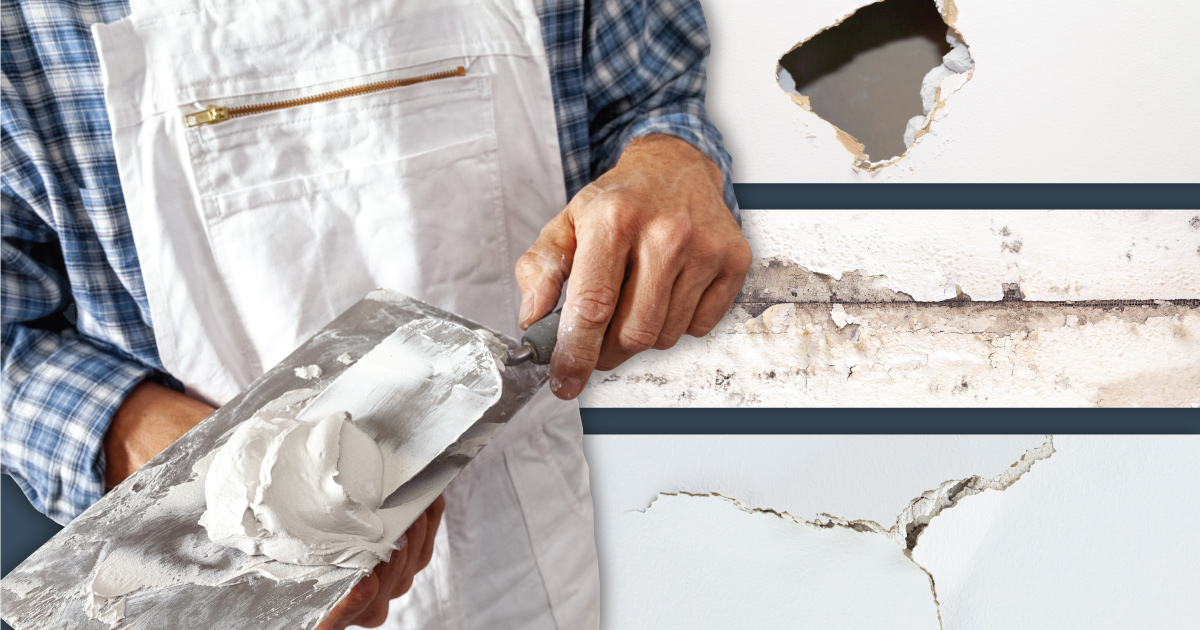This post was originally published in April 2022. Last updated: June 2025.
Drywall is used in nearly every modern home, and for valid reasons. It’s cost-effective and creates a smooth, clean surface for paint or wall treatments that homeowners can customize as they wish. But drywall isn’t immune to damage. Over the years, exposure to moisture, everyday wear, or even structural movement can take a toll. And while patching may seem like the easier fix, it’s not always the right one.

How to Tell When It’s Time to Replace Drywall
Knowing when to replace drywall isn’t always straightforward. Small cracks or dents might seem harmless at first, but they can sometimes be signs of a larger issue. And while patching may work in the short term, some problems go beyond surface fixes — and ignoring them can lead to more costly repairs down the line.
If you’ve noticed something off with your walls, it’s worth taking a closer look. Below are some of the most common signs it might be time to replace drywall entirely.
1. Visible Water Damage or Mold
Moisture and drywall don’t mix and, once water seeps in, the damage can spread quickly. Water-damaged drywall often reveals itself through discolored stains, sagging or bubbling surfaces, and a musty smell that lingers no matter how much you air out the room.
Here are the most common indicators that moisture has compromised your drywall:
- Brown or yellow stains: These typically show up after a leak and are often the first visible warning sign.
- Sagging or softness: If the drywall feels spongy to the touch or looks warped, it’s likely lost its structural integrity.
- Peeling paint or bubbling texture: Moisture trapped behind the surface can cause finishes to lift or blister.
- Mold growth: Small black, green, or gray spots on the wall are a serious concern — mold can affect your health and spread behind the drywall without being visible.
Even if the drywall looks dry after a leak, the internal core may still be weakened. Mold, in particular, is a strong indicator that you’ll need to replace drywall instead of attempting to clean or repair it. Once it’s present, especially in porous materials like drywall, removal is typically the only safe solution.
2. Large Cracks, Holes, or Structural Shifts
Not every crack in your drywall is a reason to worry, but some are. It’s important to pay attention to the size, pattern, and frequency of the damage to know when a simple patch won’t cut it.
Watch for these signs that your drywall issues may be more than cosmetic:
- Long, jagged cracks: Especially those that run diagonally from corners or door frames, since these can point to settling or structural movement.
- Cracks that keep coming back: If you've patched an area before and the crack reappears, there may be ongoing stress or shifting behind the wall.
- Large holes or punctures: Damage from furniture, accidents, or doorknobs can usually be patched if small — but anything larger than a few inches across often requires replacing a section of drywall.
- Bulging or uneven surfaces: This could mean the studs have shifted or the drywall has pulled away from the frame, both of which may need more than surface repair.
While minor imperfections can often be patched with spackle, larger or recurring damage might be a sign that it's time to replace drywall. In some cases, those cracks and holes are warning signs of foundation issues, moisture problems, or even poor installation — and simply covering them up won’t address the root cause.
3. Soft or Crumbling Drywall
Drywall should feel firm and solid when pressed. If it feels soft, powdery, or begins to crumble at the edges, it’s likely beyond repair. This kind of deterioration usually points to a larger issue — often water damage, long-term humidity exposure, or aging materials breaking down over time. In some cases, improper installation or poor-quality materials can also lead to weak spots in your walls.
Here are some telltale signs that the drywall has lost its structural integrity:
- Chalky texture: When the surface leaves residue on your fingers or flakes away, the drywall is deteriorating.
- Crumbling edges or screw holes: If sections break apart during light handling or fasteners won't hold, the core is likely compromised.
- Indentations or softness under pressure: Drywall shouldn’t give way when gently pressed, so softness means it's structurally unsound.
Once drywall reaches this stage, reinforcing it isn’t a realistic option. It won’t properly support screws or finishes, and it may even pose a safety risk if it starts to give way. The only long-term fix is to remove and replace drywall in the affected areas.
4. Recurring Nail Pops or Loose Drywall
A single nail pop isn’t unusual — especially in newer homes as materials settle — but when they keep coming back or appear in clusters, it’s a red flag. These small bumps or holes in the wall happen when drywall fasteners push through the surface, usually due to shifting framing, temperature changes, or vibration.
When these issues persist, you may notice:
- Multiple nail pops in the same area: This often means the drywall is no longer holding fasteners securely.
- Screws that won’t stay in place: If you patch a hole and it quickly loosens again, the material behind it might be soft or deteriorated.
- Wall movement or creaking: This could point to framing movement, which puts stress on the drywall and causes fasteners to shift.
Repatching over and over won’t solve the root of the problem — especially if the drywall around the fasteners has worn away. In many cases, repeated nail pops are a sign that it’s time to replace drywall altogether, especially if the panels can no longer hold securely to the studs behind them.
5. Smoke or Fire Damage
Even if your drywall looks mostly intact after exposure to smoke or fire, that doesn’t mean it’s still safe or functional. Drywall is a porous material, so it absorbs smoke, odors, and harmful particles easily. And once it’s been exposed to high heat, it can lose the rigidity that makes it reliable as a wall surface.
Here are some ways smoke and fire damage can impact your drywall:
- Persistent stains or odor: Smoke smell that lingers even after cleaning is a sign it’s soaked into the drywall itself.
- Charring or bubbling: Even mild heat can cause drywall paper to bubble or darken, weakening the bond between layers.
- Loss of structural strength: Fire-damaged drywall may feel brittle, warped, or visibly distorted, it’s no longer safe to leave in place.
Painting over smoke-stained drywall might hide the discoloration, but it won’t remove the contaminants inside the wall. For the health of your household and the safety of your home, it’s best to replace drywall that’s been exposed to significant smoke or fire — especially in kitchens, garages, or areas affected by even small blazes.
6. Age and General Wear-and-Tear
Drywall might seem like it’ll last forever, but like any building material, it wears down over time. In older homes especially, decades of use, subtle movement, and environmental exposure can leave drywall looking tired and performing poorly.
Here are a few signs that age is catching up with your drywall:
- Faded or discolored surfaces: Years of sun exposure, smoke, or general wear can dull the finish and make rooms feel dingy.
- Hairline cracks and scuffs: Small imperfections multiply with age and can become more difficult to patch effectively.
- Poor insulation or soundproofing: Older drywall may not perform as well in terms of energy efficiency or noise control.
If your home is undergoing updates or you’re looking to refresh the space, replacing old drywall can offer a big return, including better appearance, improved performance, and a clean slate for new finishes or fixtures. It’s especially worth considering in rooms where the walls just don’t look or feel quite right anymore.
7. Renovations and Layout Changes
If you’re reconfiguring a space — knocking down walls, adding new rooms, or opening things up — chances are, you’ll need to replace drywall in the process. Even if some panels seem salvageable, working with old drywall often leads to more challenges than it’s worth.
Here’s why new drywall is often the smarter choice during renovations:
- Smoother, consistent finish: Mixing old and new drywall usually results in visible seams or uneven texture that’s hard to hide with paint.
- Upgrades to wiring, plumbing, or insulation: Installing new drywall gives you a clean path to bring the rest of your home’s systems up to modern standards.
- Time and cost savings in the long run: Trying to patch and blend old drywall can take more time and labor than simply starting fresh.
Reusing drywall isn’t typically recommended since it’s prone to damage when removed and rarely fits the new layout perfectly. Installing new panels gives the space a cleaner, more cohesive feel that holds up better over time.
What to Expect When You Replace Drywall
Whether you're repairing a single wall or tackling an entire room, replacing drywall is a job that comes with time, cost, and a fair amount of dust. But knowing what to expect can help you plan the project and decide if it’s something you want to DIY or hire out.
Here’s a quick breakdown of what’s involved in the drywall replacement process:
- Labor and tools: Removing damaged drywall, measuring and cutting new panels, securing them to studs, and taping and mudding seams all take time — and some specialized tools like a utility knife, T-square, and sanding pole.
- Dust and debris: Demo and sanding can get messy fast. Cover nearby furniture and vents and be ready for a full cleanup afterward.
- Project timeline: Drywall installation can take a few days depending on the size of the job. Plus, mudding and drying times add up quickly.
- Costs to consider: On average, homeowners spend $1.50 to $3.50 per square foot, depending on whether they’re doing the work themselves or hiring a contractor. Labor costs vary widely, so getting a few quotes can help narrow it down.
DIY replacement is doable for small areas — like a single wall — especially if you’re comfortable with basic tools. But for larger spaces or ceiling work, bringing in a professional can save you time and ensure a smooth, polished finish that lasts.
Looking for an Alternative? Consider Trusscore Wall&CeilingBoard
If you’re constantly dealing with damaged drywall — or you’re renovating a space where durability and moisture resistance matter — it might be time to consider a better option: Trusscore Wall&CeilingBoard is a high-performance alternative to traditional drywall that’s built to last, even in the toughest environments.
Here’s how Trusscore stands out from standard drywall:
- Faster installation: Pre-finished panels interlock and go up quickly with just screws— no taping, mudding, sanding, or painting required.
- Water-resistant and mold-proof: Unlike drywall, Trusscore is 100% waterproof so won’t swell, rot, or support mold growth, even in damp or wet areas.
- Easy to clean: Wiping dirt and debris off Trusscore panels only requires soap and water — no scrubbing or harsh chemicals needed.
- Tough and impact-resistant: Scratch, dent, and damage-resistant, Trusscore is designed to handle everyday wear and tear in garages, laundry rooms, utility spaces, and more.
If you’re tired of replacing drywall every time it gets damaged, it might be time to consider a smarter, more durable solution like Trusscore Wall&CeilingBoard. It offers a clean, bright finish and peace of mind that it’ll hold up over time.
Damaged drywall isn’t just an eyesore — it can signal deeper issues that affect the safety, performance, and value of your home. Whether you’re dealing with moisture, age, or recurring cracks, ignoring the problem can lead to more costly repairs down the road.
Take the time to inspect your walls and trust your instincts. If the damage keeps coming back or the drywall no longer feels solid, replacement is often the best path forward. A qualified contractor can help you assess what needs to go — and what can be salvaged. And if you’re looking for a longer-term solution, exploring alternatives like Trusscore Wall&CeilingBoard can give you the durability and low-maintenance finish traditional drywall just can’t match.



